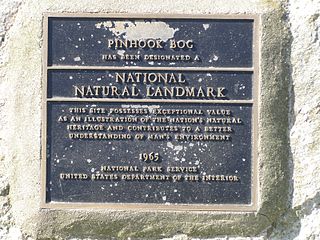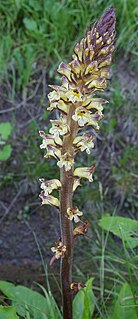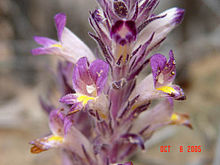
Orobanche is a genus of over 200 species of parasitic herbaceous plants in the family Orobanchaceae, mostly native to the temperate Northern Hemisphere. Some species formerly included in this genus are now referred to the genus Conopholis. The broomrape plant is small, from 10–60 cm tall depending on species. It is best recognized by its yellow- to straw-coloured stems completely lacking chlorophyll, bearing yellow, white, or blue snapdragon-like flowers. The flower shoots are scaly, with a dense terminal spike of between ten and twenty flowers in most species, although single in O. uniflora. The leaves are merely triangular scales. The seeds are minute, tan-to-brown, and blacken with age. These plants generally flower from late winter to late spring. When they are not flowering, no part of the plants is visible above the surface of the soil.

Orobanchaceae, the broomrapes, is a family of mostly parasitic plants of the order Lamiales, with about 90 genera and more than 2000 species. Many of these genera were formerly included in the family Scrophulariaceae sensu lato. With its new circumscription, Orobanchaceae forms a distinct, monophyletic family. From a phylogenetic perspective, it is defined as the largest crown clade containing Orobanche major and relatives, but neither Paulownia tomentosa nor Phryma leptostachya nor Mazus japonicus.

Conopholis americana, the American cancer-root, squawroot, bumeh or bear corn, is a perennial, non-photosynthesizing parasitic plant, from the family Orobanchaceae and more recently from the genus Conopholis but also listed as Orobanche, native but not endemic to North America and when blooming, resembles a pine cone or cob of corn growing from the roots of mostly oak and beech trees. It gets its common name for its usage by Native American women to treat menstrual cramps and other female ailments, due to its astringency.

A parasitic plant is a plant that derives some or all of its nutritional requirement from another living plant. They make up about 1% of angiosperms and are found in almost every biome. All parasitic plants have modified roots, called haustoria, which penetrate the host plant, connecting them to the conductive system – either the xylem, the phloem, or both. For example, plants like Striga or Rhinanthus connect only to the xylem, via xylem bridges (xylem-feeding). Alternately, plants like Cuscuta and Orobanche connect only to the phloem of the host (phloem-feeding). This provides them with the ability to extract water and nutrients from the host. Parasitic plants are classified depending as to the location where the parasitic plant latches onto the host and the amount of nutrients it requires. Some parasitic plants are able to locate their host plants by detecting chemicals in the air or soil given off by host shoots or roots, respectively. About 4,500 species of parasitic plant in approximately 20 families of flowering plants are known.

Pinhook Bog is a unique bog in Indiana that has been designated a National Natural Landmark. It is part of Indiana Dunes National Park, an area that many citizens, scientists, and politicians fought hard to preserve. Its sister bog, Volo Bog, is located nearby. The bog contains a large variety of plants, including insect eating plants, tamarack trees, stands of blueberry bushes, and floating mats of sphagnum moss. Pinhook Bog is about 580 acres (2.3 km2), a quarter of which is a floating mat of sphagnum peat moss. A "moat" separates the bog from the uplands.

Orobanche uniflora, commonly known as one-flowered broomrape, one-flowered cancer root, ghost pipe or naked broomrape, is an annual parasitic herbaceous plant. It is native to much of North America, where it is a parasitic plant, tapping nutrients from many other species of plants, including those in the families Asteraceae and Saxifragaceae and in the genus Sedum. The name "orobanche" can be translated to "vetch-strangler" and "uniflora" can be translated to "single-flower".

Artemisia ludoviciana is a North American species of flowering plant in the daisy family Asteraceae, known by several common names, including silver wormwood, western mugwort, Louisiana wormwood, white sagebrush, and gray sagewort.

Orobanche minor, the hellroot, common broomrape, lesser broomrape, small broomrape or clover broomrape, is a holoparasitic flowering plant belonging to the genus Orobanche; a genus of about 150 non-photosynthetic plants that parasitize other autotrophic plants.

Orobanche californica, known by the common name California broomrape, is a species of broomrape. It is a parasitic plant growing attached to the roots of other plants, usually members of the Asteraceae.

Orobanche corymbosa is a species of broomrape known by the common name flat-top broomrape. It is native to western North America where it is a parasite growing attached to the roots of other plants, usually sagebrush. It produces a cluster of thick, glandular stems with enlarged bases and stout roots, the hairy stems pale whitish or yellowish, often purple-tinged, and up to 17 centimetres (6.7 in) tall. As a parasite taking its nutrients from a host plant, it lacks leaves and chlorophyll. The inflorescence is a wide array of a few tubular flowers. Each is 2 centimetres (0.79 in) or 3 centimetres (1.2 in) long, coated in glandular hairs, and dark-veined pink or purple in color.

Orobanche fasciculata is a species of broomrape known by the common name clustered broomrape. It is native to much of western and central North America from Alaska to northern Mexico to the Great Lakes region, where it grows in many types of habitat. It is a parasite growing attached to the roots of other plants, usually members of the Asteraceae such as Artemisia; and other genres such as Eriodictyon and Eriogonum. This plant produces one or more stems from a thick root, growing erect to about 20 centimeters in maximum height. As a parasite taking its nutrients from a host plant, it lacks leaves and chlorophyll. It is variable in color, often yellowish or purple. The inflorescence is a raceme of up to 20 flowers, each on a pedicel up to 15 centimetres (5.9 in) long. Each flower has a calyx of hairy triangular sepals and a tubular corolla 1.5–3 centimetres (0.59–1.18 in) long. The flower is yellowish or purplish in color.
Orobanche pinorum is a species of broomrape known by the common name conifer broomrape. It is native to the forests of western North America, where it is a parasite growing attached to the roots of other plants, usually Holodiscus species. This plant has an erect stem with a wide, thickened base and slender top growing 10–30 centimetres (3.9–11.8 in) tall. As a parasite taking its nutrients from a host plant, it lacks leaves and chlorophyll and is brownish or yellowish in color. The inflorescence is a dense, spreading array of purple-tinged yellowish flowers 1–2 centimetres (0.39–0.79 in) long.
Orobanche valida is a species of broomrape known by the common name Rock Creek broomrape. It is endemic to California, where its two uncommon subspecies grow in mountainous habitats separated by several hundred miles. Howell's broomrape, ssp. howellii, is limited to the North Coast Ranges north of the San Francisco Bay Area, where it grows in chaparral, often on serpentine soils. The similarly rare subspecies valida is known from only four occurrences in the Transverse Ranges. The plant is a parasite growing attached to the roots of other plants, generally shrubs; ssp. howellii can often be found on Garrya species. The plant produces a hairy, glandular purple stem up to about 35 centimeters tall. As a parasite taking its nutrients from a host plant, it lacks leaves and chlorophyll. The inflorescence is a small cluster of tubular purple flowers 1 to 2 centimeters long.

Orobanche rapum-genistae, the greater broomrape, is a plant species in the genus Orobanche. It is a parasitic plant, native to Europe, growing on the roots of plants in the bean family, usually common broom or European gorse.
Desert broomrape can refer to several parasitic plants in the family Orobanchaceae, including:
Lactuca ludoviciana, the biannual lettuce, is a North American species of wild lettuce. It is widespread across much of central and western Canada and the western and central United States from Ontario west to British Columbia and south to Louisiana, Texas, and California. Most of the known populations are on the Great Plains; populations west of there may well represent naturalizations.

Orobanche hederae, the ivy broomrape, is, like other members of the genus Orobanche, a parasitic plant without chlorophyll, and thus totally dependent on its host, which is ivy. It grows to 60 cm (2 ft), with stems in shades of brown and purple, sometimes yellow. The flowers are 10–22 mm (0.4–0.9 in) long, cream in colour with reddish-purple veins.

Orobanche reticulata is a species of broomrape known by the common name thistle broomrape. It is a parasitic plant whose host is normally the creeping thistle. It is native to the lowlands of Western Europe and Central Asia, but in the United Kingdom it is a rare and protected plant, growing only in Yorkshire, on grassland sites such as Quarry Moor.

Orobanche latisquama is a species of broomrape in the family Orobanchaceae native to the western Mediterranean Basin. It is a parasite of rosemary and probably other shrubs.

Physaria ludoviciana is a species of flowering plant in the mustard family Brassicaceae, with the common names of bladder pod, silver bladderpod, and foothill bladderpod. It used to be Lesquerella ludoviciana which is now a synonym.
















